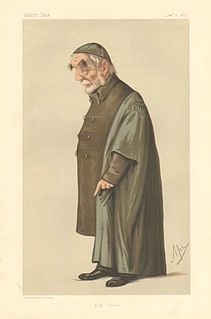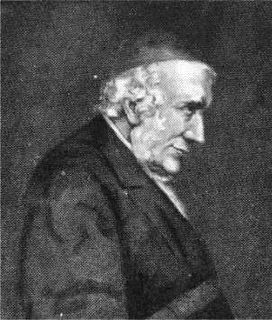
Anglo-Catholicism comprises beliefs and practices that emphasise the Catholic heritage and identity of the various Anglican churches.

John Henry Newman was an English theologian, scholar and poet, first an Anglican priest and later a Catholic priest and cardinal, who was an important and controversial figure in the religious history of England in the 19th century. He was known nationally by the mid-1830s, and was canonised as a saint in the Catholic Church in 2019.

Charles Kingsley was a broad church priest of the Church of England, a university professor, social reformer, historian, novelist and poet. He is particularly associated with Christian socialism, the working men's college, and forming labour cooperatives, which failed, but encouraged later working reforms. He was a friend and correspondent of Charles Darwin.

Edward Bouverie Pusey was an English Anglican cleric, for more than fifty years Regius Professor of Hebrew at the University of Oxford. He was one of the leading figures in the Oxford Movement.
Apologetics is the religious discipline of defending religious doctrines through systematic argumentation and discourse. Early Christian writers who defended their beliefs against critics and recommended their faith to outsiders were called Christian apologists. In 21st-century usage, apologetics is often identified with debates over religion and theology.
Thomas Mozley, was an English clergyman and writer associated with the Oxford Movement.

The Oxford Movement was a movement of high church members of the Church of England which eventually developed into Anglo-Catholicism. The movement, whose original devotees were mostly associated with the University of Oxford, argued for the reinstatement of some older Christian traditions of faith and their inclusion into Anglican liturgy and theology. They thought of Anglicanism as one of three branches of the "one, holy, catholic, and apostolic" Christian church. By the 1840s many participants decided that the Anglican Church lacked grace, and converted to Roman Catholicism.

Henry William Wilberforce, was a Church of England clergyman, a Tractarian, a convert to the Roman Catholic Church, and thereafter a newspaper proprietor, editor and journalist
Remarks on Certain Passages in the Thirty-Nine Articles, better known as Tract 90, was a theological pamphlet written by the English theologian and churchman John Henry Newman and published in 1841. It is the most famous and the most controversial of the Tracts for the Times produced by the first generation of the Anglo-Catholic Oxford Movement.

The Venerable Ignatius of St Paul, born as George Spencer, was a son of the 2nd Earl Spencer. He converted from Anglicanism to the Roman Catholic Church and entered the Passionist religious order in 1847 and spent his life working for the conversion of England to the Catholic faith.

Thomas Scott (1747–1821) was an influential English preacher and author. He is principally known for his widespread work A Commentary On The Whole Bible, for The Force of Truth, and as one of the founders of the Church Missionary Society.

An apologia is a formal defense of an opinion, position or action. The term's current use, often in the context of religion, theology and philosophy, derives from Justin Martyr's First Apology and was later employed by John Henry Newman's Apologia Pro Vita Sua of 1864, which presented a formal defense of the history of his Christian life, leading to his acceptance by the Catholic Church in 1845. In modern usage, apologia describes a formal defense and should not be confused with the sense of the word 'apology' as an expression of regret; however, apology may mean apologia, depending on the context of use.
Edward Lowth Badeley was an English ecclesiastical lawyer and member of the Oxford Movement who was involved in some of the most notorious cases of the 19th century.

Ambrose St John was a convert to Catholicism and an English Oratorian. He was a classical scholar and a linguist both in Oriental and European tongues. He is best known as a lifelong friend of Cardinal John Henry Newman.

Loss and Gain is a philosophical novel by John Henry Newman published in 1848. It depicts the culture of Oxford University in the mid-Victorian era and the conversion of a young student to Roman Catholicism. The novel went through nine editions during Newman's lifetime, and thirteen printings. It was the first work Newman published after his conversion to Roman Catholicism in 1845.
Henry Ignatius Dudley Ryder was an English Roman Catholic priest of the Birmingham Oratory and controversialist.

Henry Dudley Ryder was a prominent English evangelical Anglican bishop in the early years of the nineteenth century. He was the first evangelical to be raised to the Anglican episcopate.

Anti-Catholicism in the United Kingdom has its origins in the English and Irish Reformations under King Henry VIII and the Scottish Reformation led by John Knox. Within England the Act of Supremacy 1534 declared the English crown to be "the only supreme head on earth of the Church in England" in place of the pope. Any act of allegiance to the latter was considered treasonous because the papacy claimed both spiritual and political power over its followers. Ireland was brought under direct English control starting in 1536 during the Tudor conquest of Ireland. The Scottish Reformation in 1560 abolished Catholic ecclesiastical structures and rendered Catholic practice illegal in Scotland. Today, anti-Catholicism remains common in the United Kingdom, with particular relevance in Scotland and Northern Ireland.
Edward Hawkins was an English churchman and academic, a long-serving Provost of Oriel College, Oxford known as a committed opponent of the Oxford Movement from its beginnings in his college.
Geraldine Penrose Fitzgerald was an Irish novelist and catholic convert.













